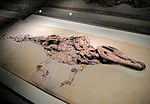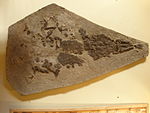- Diplocynodon
-
Diplocynodon
Temporal range: Paleocene–Middle Miocene
Diplocynodon darwini Scientific classification 
Kingdom: Animalia Phylum: Chordata Class: Reptilia Superorder: Crocodylomorpha Order: Crocodylia Superfamily: Alligatoroidea Subfamily: 2010 - †D. gervaisi
- †D. hantoniensis (Wood, 1846)
- †D. muelleri (Kälin, 1936)
- †D. ratelii Pomel, 1847 (type)
- †D. tormis
- †D. ungeri (Prangner, 1845)
Synonyms - Caimanosuchus
- Enneodon Pranger, 1845
- ?Hispanochampsa Kälin, 1936
- Saurocainus
Diplocynodon is an extinct genus of alligatoroid that lived during the Paleocene to middle Miocene 49 million years ago in Europe. It looked very similar to the modern caiman in that it was small and had bony armour scutes covering its neck, back, belly, and tail. The longest Diplocynodon recovered was 4 feet in length and probably fed on fish, animal flesh, and took insects when young.
In the nineteenth century, D. steineri was named from Styria, Austria and D. styriacus was named from Austria and France. A third Austrian species, Enneodon ungeri, was placed in its own genus. The Austrian and French species of Diplocynodon were synonymized with E. ungeri in 2011, and because the name Diplocynodon has priority over Enneodon, the species is now called D. ungeri. [1]
Well preserved specimens have been found in the Messel Pit in Germany. In the Eocene epoch, the pit was a swampy freshwater lake that was perfect for preserving fossils due to anoxic conditions at its bottom.
Contents
Species
Species Species Age Location Unit Notes Images D. dalpiazi
Late Rupelian
D. darwini
All specimens are from Messel pit of Germany. Synonyms are: Caimanosuchus brevirostris, D. ebertsi and D. hallense.
D. elavericus[2]
Middle Priabonian
All specimens came from Allier, Massif Central of France.
D. gervaisi
Earliest Rupelian
Ronzon
Synonyms are: Saurocainus gervaisi.
D. hantoniensis
Early Priabonian
Headon Hill Formation
All specimens came from Hordwell, southern England. D. cf. hantoniensis is known from the Oligocene of Dordogne, France.
D. muelleri[3]
Middle Rupelian
El Talladell
More than 100 are known, all from Lleida Province, Catalonia. Synonyms are: Hispanochampsa muelleri, D. guerini and D. marini.
D. ratelii
- Middle Aquitanian*
- Late Eocene to Early Miocene
D. ratelii is the type species of Diplocynodon. Most of the specimens came from Allier, Massif Central of France. Synonyms are: D. gracile.
D. tormis
Late Bartonian
D. ungeri[1]
Middle Miocene
Synonyms are: Enneodon ungeri, D. steineri, and D. styriacus (see text).
*Locality and/or horizon of the type specimen.
Phylogeny
Cladogram based on Martin, 2010:[2]
Alligatoroidea Globidonta
Diplocynodontidae Baryphracta
Diplocynodon D. darwini
D. hantoniensis
D. ratelii
D. elavericus
D. muelleri
D. tormis
References
- ^ a b Jeremy E. Martin and Martin Gross (2011). "Taxonomic clarification of Diplocynodon Pomel, 1847 (Crocodilia) from the Miocene of Styria, Austria". Neues Jahrbuch für Geologie und Paläontologie - Abhandlungen 261 (2): 177–193. doi:10.1127/0077-7749/2011/0159. http://www.ingentaconnect.com/content/schweiz/njbgeol/2011/00000261/00000002/art00004.
- ^ a b Jeremy E. Martin (2010). "A new species of Diplocynodon (Crocodylia, Alligatoroidea) from the Late Eocene of the Massif Central, France, and the evolution of the genus in the climatic context of the Late Palaeogene". Geological Magazine 147: 596–610. doi:10.1017/S0016756809990161. http://journals.cambridge.org/action/displayAbstract?fromPage=online&aid=7792029.
- ^ Paolo Pirasa and Angela D. Buscalionib (2006). "Diplocynodon muelleri comb. nov., an Oligocene diplocynodontine alligatoroid from Catalonia (Ebro Basin, Lleida Province, Spain)". Journal of Vertebrate Paleontology 26 (3): 608–620. doi:10.1671/0272-4634(2006)26[608:DMCNAO]2.0.CO;2. http://www.bioone.org/doi/abs/10.1671/0272-4634(2006)26%5B608:DMCNAO%5D2.0.CO%3B2.
- Fossils (Smithsonian Handbooks) by David Ward (Page 243)
External links
This article about a prehistoric archosaur is a stub. You can help Wikipedia by expanding it.



